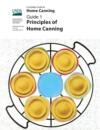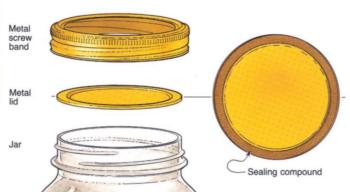Canning
Canning is a method of food preservation where foods are processed and stored in an airtight container.

Is canning foods safe?
Food made and processed with a tested recipe should be safe if you follow the directions and use the right equipment.
The foods we preserve come in 2 types: high-acid foods (pH at or below 4.6) and low-acid foods (pH above 4.6). Each type requires a different processing technique to maintain safety. At pH above 4.6—low acid foods—botulism can form.
Home canning uses glass jars. Current recommendations by USDA are to only use jars with a 2-piece lid secured with a ring during processing. (See image below.)

High-Acid Foods
Most fruits, sweet spreads, pickles and many salsas are high-acid foods. They have a pH at or below 4.6. High-acid foods can be preserved by processing in a water-bath or steam canner. Acid inhibits the growth of Botulinum bacteria, and the processing kills other harmful organisms present.
Don’t alter recipes or you risk raising the pH and exposing yourself and loved ones to botulism. If you have a special recipe that just doesn’t match up with a tested recipe, try freezing it instead.
You can find more information about canning high-acid foods on our website.
Low-Acid Foods
Most vegetables, all meats, soups, and some fruits are not acidic enough to retard the growth of Botulinum and therefore must be processed in a pressure canner. Pressure canners are not hard to use and are safe, but they must be used correctly.
Pressure canners are not the same thing as a pressure cooker! This page has information on acceptable pressure canners. Along these lines, Insta-Pots, while popular now, are not pressure canners.
We have more information on pressure canning on our website.
Tomatoes

Click this link for more information on canning tomatoes.
Substituting Peppers in Recipes
Most of California has access to a wide variety of pepper types, but rural areas like the Eastern Sierra are not so lucky? What should you do if you cannot find the right peppers or you are suffering from a overabundance of chileno peppers?
We have posted a page with information of how to safely substitute peppers in canning recipes to either adjust the heat level or to make up for a lack of options.
Click this link for information on substituting pepper types.
Common Questions
Is open-kettle canning OK?
NO! Open-kettle canning is not considered safe.
“Open-Kettle” is the practice of putting a lid on a hot product and allowing a seal to form as the product cools. There is no processing involved and molds, yeasts, and other organisms can grow. As these microorganisms grow they can affect pH and allow spoilage. Please properly process all canned good according to a tested recipe.
How do I adjust a canning recipe for my altitude?
If you live in Inyo or Mono counties, you will need to adjust processing to compensate for elevation. Recipes by USDA, University of Georgia, and most Cooperative Extension sites will include adjustments for elevation in the instructions.
Many sites that share non-tested recipes do not include altitude adjustments. This omission is a good indicator that you potentially may be using a dangerous or untested recipe.
You can adjust recipes for elevation based on these tables.
As elevation increases, the temperature that water boils decreases. This impacts baking and cooking, but also affects how long it takes to reduce sauces and set jams and jellies.
|
Altitude (feet) |
Water Boils at (°F) |
|
14,505 |
186°F |
|
10,000 |
194°F |
|
8,000 |
197°F |
|
6,000 |
201°F |
|
4,000 |
204°F |
|
2,000 |
208°F |
|
0 (Sea Level) |
212°F |
|
-282 |
213°F |
Most home cooks find that it may take twice as long to cook down sauces and fruits as most recipes meant for sea level suggest. Keep an eye on your progress when you cook and plan for some extra time.
USDA has this information on High Altitude Cooking and Food Safety.
Where Can I Find Tested Recipes?
A list of trusted sources we recommend can be found at this page. These are places where we get the recipes that we share with you at our workshops.
There are thousands of recipes on the Internet, but many are not safe. If you are using a recipe from our recommended sites, you will be OK. Some sites re-post these tested recipes. You can compare the two if you are unsure.
If you encounter a recipe that you are unsure about, chances are it is not a tested recipe. We find many recipes that are potentially dangerous.
There are no tested recipes for butter, nuts, pumpkin/squash purée, and bananas. Consider using the freezer instead.
But I Can’t Find a Recipe For _____________?
Sometimes the thing you want to make just doesn’t have a process that is safe or tested with home canning equipment. In this case you should use an alternate preservation process such as freezing. In some cases, freezing is easier and more appropriate than canning if there is an approved process.
More Questions?
Please contact us at our helpline: immg@ucanr.edu
